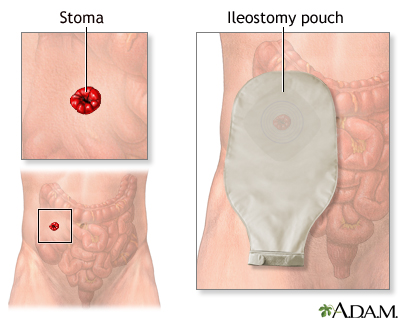Types of ileostomy
Ileostomy - types; Standard ileostomy; Brooke ileostomy; Continent ileostomy; Abdominal pouch; End ileostomy; Ostomy; Inflammatory bowel disease - ileostomy and your ileostomy type; Crohn disease - ileostomy and your ileostomy type; Ulcerative colitis - ileostomy and your ileostomy type

An ileostomy is used to move waste out of the body through a surgically-created opening called a stoma. This surgery is done when the colon or rectum is not working properly. The word ileostomy comes from the words ileum, which is the lowest part of the small intestine, and stoma, which means opening. To make an ileostomy, the surgeon makes an opening in the belly wall and brings the end of the ileum through the opening. The ileum is then attached to the skin. The stoma is connected to a pouch, which needs to be emptied several times a day and changed periodically.
What to Expect at Home
Stool that comes from your ileostomy is thin or thick liquid. It is not solid like the stool that came from your rectum. You must take care of the skin around the stoma.
You can still do normal activities, such as traveling, playing sports, swimming, doing things with your family, and working. You will learn how to take care of your stoma and pouch as part of your daily routine. Your ileostomy will not shorten your life.
What Does an Ileostomy Do?
An ileostomy is a surgically made opening on the skin of the belly. An ileostomy replaces the rectum as the place where waste of the digestive system (stool) leaves the body.
Most often the colon (large intestine) absorbs most of the water that you eat and drink. With an ileostomy in place, the colon is no longer being used. This means that the stool from your ileostomy has far more liquid than a typical bowel movement from the rectum.
The stool now comes out from the ileostomy and empties into a pouch that is attached to the skin around your stoma. The pouch is made to fit your body well. You must wear it all the time.
The waste that collects will be liquid or pasty, depending on what you eat, what medicines you take, and other things. Waste collects constantly, so you will need to empty the pouch 5 to 8 times a day.
Standard Ileostomy
The standard ileostomy is the most common kind of ileostomy that is done.
- The end of the ileum (part of your small intestine) is pulled through the wall of your abdomen.
- Then it is sewn to your skin.
- It is normal that the ileostomy bulges out an inch (2.5 centimeters) or so. This makes the ileostomy like a spout, and it protects the skin from being irritated from the stool.
Most times, the stoma is placed in the right lower part of the belly on a flat surface of normal, smooth skin.
An ileostomy can be permanent or temporary. In temporary situations, a type called a loop ileostomy is formed by the surgeon. This can be taken down and the bowel reconnected after some time.
Continent Ileostomy (Abdominal Pouch)
A continent ileostomy is a different type of ileostomy. With a continent ileostomy, a pouch that collects waste is made from part of the small intestine. This pouch stays inside your body, and it connects to your stoma through a valve that your surgeon creates. The valve prevents the stool from constantly draining out, so that you usually do not need to wear a pouch.
Waste is drained by putting a tube (catheter) through the stoma a few times each day.
Continent ileostomies are not done very often anymore. They can cause many problems that need medical treatment, and sometimes they need to be redone.
References
American Cancer Society website. About ileostomies.
American Cancer Society website. Types of ileostomies.
Raza A, Araghizadeh F. Ileostomy, colostomy, and pouches. In: Feldman M, Friedman LS, Brandt LJ, eds. Sleisenger and Fordtran's Gastrointestinal and Liver Disease. 11th ed. Philadelphia, PA: Elsevier; 2021:chap 117.
United Ostomy Associations of America website. Ileostomy facts.
.
Version Info
Last reviewed on: 10/30/2024
Reviewed by: Jenifer K. Lehrer, MD, Gastroenterologist, Philadelphia, PA. Review provided by VeriMed Healthcare Network. Also reviewed by David C. Dugdale, MD, Medical Director, Brenda Conaway, Editorial Director, and the A.D.A.M. Editorial team.
